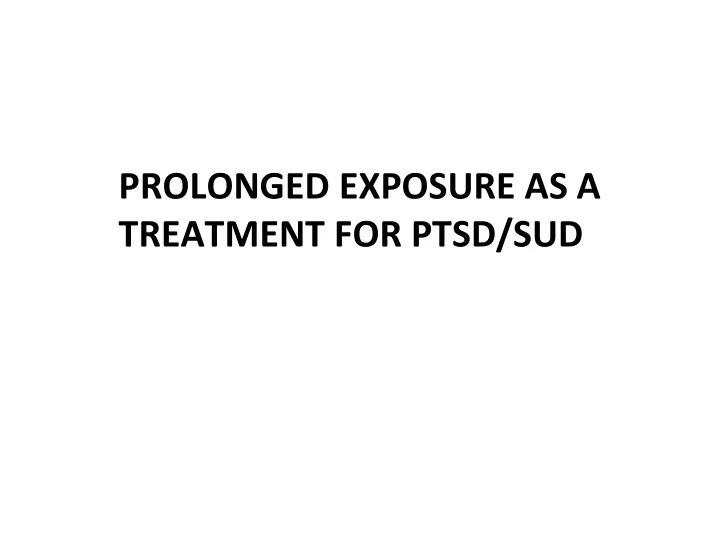

PROLONGED EXPOSURE AS A TREATMENT FOR PTSD/SUD
The Fear Structure • A fear structure is a program for escaping danger • It includes information about: – The feared stimuli – The fear response – The meaning of stimuli and responses
Trauma Memory • A specific fear structure that contains representations of: – Stimuli present during and after the trauma – Physiological and behavioral responses that occurred during the trauma – Meanings associated with these stimuli and responses – Associations may be realistic or unrealistic
Characteristics of early trauma structure • Large number of stimuli • Excessive responses [PTSD symptoms] • Erroneous associations between stimuli and “danger” • Erroneous associations between responses and “incompetence” • Fragmented and poorly organized relationships between representations
Early PTSD symptoms • Trauma reminders in daily life activate trauma memory and the associated perception of “danger” and “self incompetence” • Activation of the trauma memory is reflected in re-experiencing symptoms and arousal • Re-experiencing and arousal lead to avoidance behavior
Recovery Process • Recovery is the norm!!! • Repeated activation of trauma memory and emotional engagement • Incorporation of corrective information about “world” and “self” • Activation and disconfirmation occur via confronting trauma reminders [thinking about, and contact with, trauma reminders] • Corrective information consists of absence of anticipated harm
Chronic PTSD • While avoidance may be helpful short term, over long term it is harmful • Persistent cognitive and behavioral avoidance prevents change in trauma memory by: – Limiting activation of trauma memory – Limiting exposure to corrective information – Limiting articulation of trauma memory and thus preventing organization of the memory
Erroneous cognitions underlying PTSD • The world is extremely dangerous • People are untrustworthy • No place is safe • I am extremely incompetent • PTSD symptoms are a sign of weakness • Other people would have prevented the trauma
Prolonged Exposure Therapy for PTSD • Imaginal exposure: revisiting the trauma memory (30-45 minutes during sessions 3-12) and processing it (15 minutes) • In vivo exposure: to trauma reminders in life between sessions • Education: about common reactions to trauma (25 minutes in session 2) • Breathing retraining: 10 minutes in session 1 • 9-12 weekly or twice-weekly 90 minute sessions • Allow patients to process memory, better differentiate past from present, and gain an improved sense of control and mastery over the memory
Endorsements • More than 20 years of research supports its use • In 2001, Prolonged Exposure for PTSD received an Exemplary Substance Abuse Prevention Program Award from the U.S. Department of Health and Human Services Substance Abuse and Mental Health Services Administration (SAMHSA). • Prolonged exposure was selected by SAMHSA and the Center for Substance Abuse Prevention as a Model Program for national dissemination. • the VA Office of Mental Health Services has funded a national rollout to disseminate PE into VA hospitals as a treatment of choice for veterans suffering from PTSD • 2008 IoM report: upheld the efficacy of PE in treatment of PTSD • International Consensus Group on Depression and Anxiety: identified exposure as the first-line psychosocial intervention and the single most important treatment for reducing PTSD symptoms
Some data • produce clinically significant improvement in about 80% of patients with chronic PTSD (Eftekhari, Stines, & Zoellner, 2006) • A more recent meta-analytic review of prolonged exposure showed that the average PE-treated patient fared better than 86% of patients in control conditions at post- treatment on PTSD measures (Powers, Halpern, Ferenschak, Gillihan, & Foa, 2010).
PE data • Consistent improvements in depression, anxiety, and global functioning • Clinically significant and lasting improvements in negative cognitions about one’s self, the world, and self -blame (Foa, & Rauch, 2004) • Reductions in anger, particularly in those with high baseline anger (Cahill et al., 2003) • Reductions in dissociation (Taylor et al., 2003) • Even those with co morbid axis I and axis II benefit from PE (depression, anxiety, substance use, and personality disorders NOT significant predictors of treatment response) (Van Minnen et al., 2002) • Demonstrated efficacy around a variety of trauma and variety of ethnic and cultural groups • Adding PE to sertraline partial responders: improved response rates and end of treatment and follow-up (Cahill et al., 2004) • PE can be successfully disseminated by community therapists
Recommend
More recommend